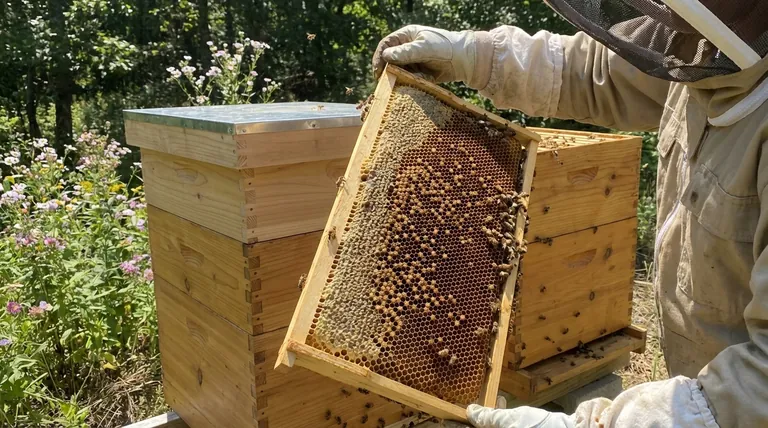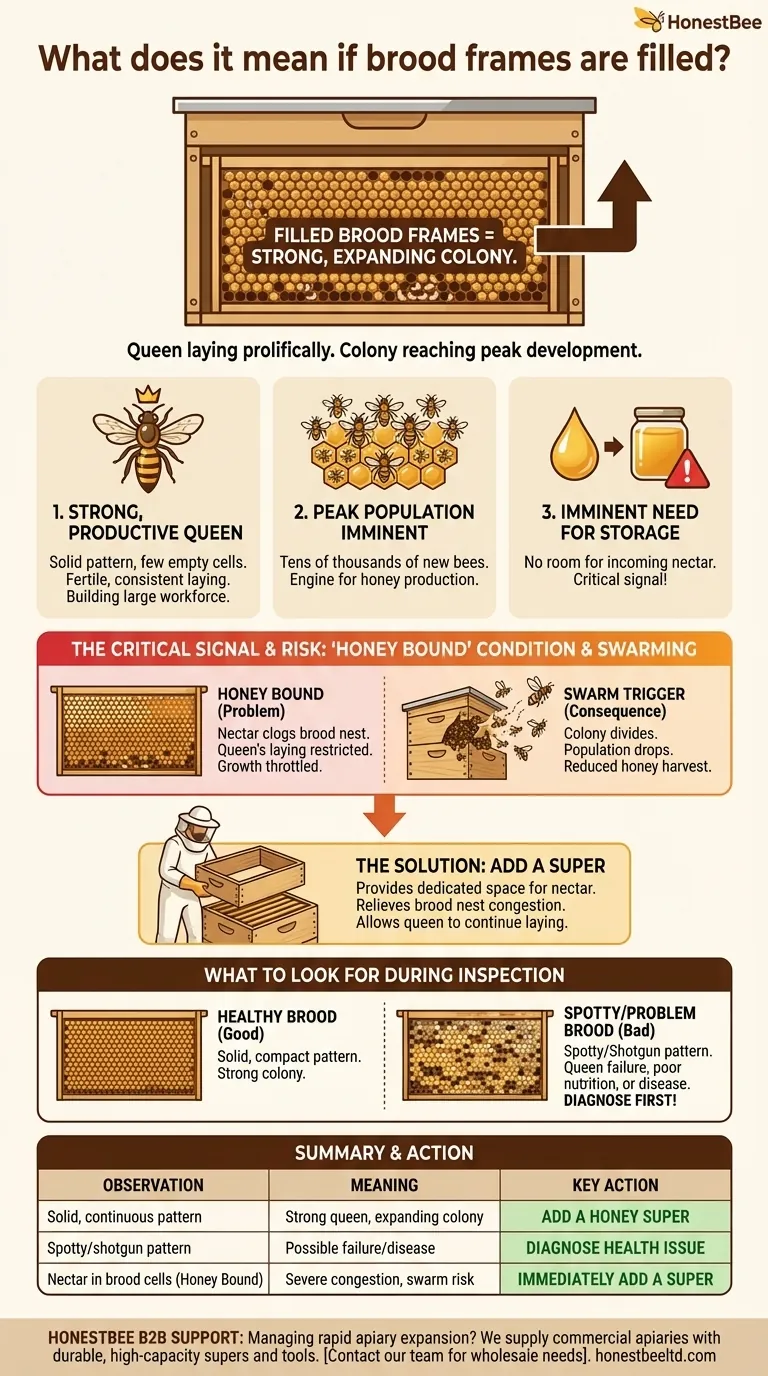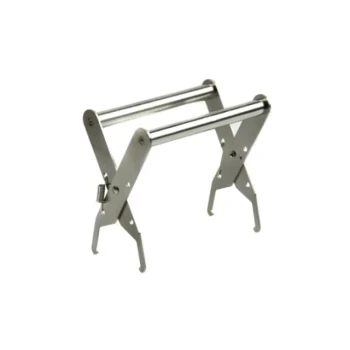In beekeeping, filled brood frames are a definitive sign of a strong, expanding colony. The frames within the brood box, which is the lower section of the hive, are packed with eggs, larvae, and capped pupae in a continuous pattern. This indicates your queen is laying prolifically and the colony is reaching a critical point in its seasonal development, signaling an immediate need for more space to store incoming nectar.
A hive with filled brood frames is communicating a critical need. It has successfully maximized its population-rearing space and now requires you to provide dedicated room for honey storage to prevent congestion and a potential swarm.

What "Filled Brood Frames" Reveal About Your Colony
Observing frames completely dedicated to brood is more than just a quick check; it’s a detailed snapshot of your colony's health and momentum. Understanding these signals allows you to manage the hive proactively.
A Sign of a Strong, Productive Queen
A frame filled from edge to edge with brood in successive stages is the hallmark of a healthy queen. This solid brood pattern, with few to no empty cells, shows she is fertile and laying consistently.
It confirms that the colony has the genetic foundation and leadership required to build a large workforce for the main nectar flow.
The Colony is Nearing Peak Population
Brood represents the next generation of bees. When the brood frames are full, it means a population boom is imminent.
In a matter of days and weeks, tens of thousands of new worker bees will emerge, ready to forage. This is the engine that drives honey production.
An Imminent Need for Honey Storage
Bees instinctively keep the brood nest and honey storage areas separate. When the brood chamber is full, arriving foragers have nowhere to deposit incoming nectar.
This forces them to store nectar in the brood area, a condition that will quickly lead to problems.
The Critical Signal: Interpreting a Full Brood Nest
A full brood nest is a positive sign, but it is also a warning. It signals that the hive is approaching a tipping point where its success can trigger a reproductive event—swarming—that can severely impact your honey harvest.
The "Honey Bound" Condition
If you fail to provide more space, the bees will begin storing nectar in the empty cells within the brood nest. This is known as becoming honey bound.
This clogs the nest and restricts the queen's ability to lay eggs, effectively throttling the colony's growth right when it should be at its peak.
The Primary Swarm Trigger
Lack of space is the most significant trigger for swarming. When the colony feels congested and the queen has no room to lay, the bees' instinct is to divide.
They will raise a new queen and the old queen will leave with up to half the workforce. This dramatically reduces the hive's population and its ability to gather a surplus honey crop.
The Unmistakable Signal to Add a Super
The most direct and necessary response to filled brood frames is to add a super. A super is an additional hive box placed on top of the brood chamber, intended exclusively for honey storage.
Adding a super provides the necessary space for foragers to store nectar, relieving congestion in the brood nest and allowing the queen to continue laying.
Understanding the Nuances: What to Look For During Inspection
Simply seeing a "full" frame is not enough. A true expert assesses the quality of what fills the frame. Distinguishing between a healthy, full frame and a problematic one is crucial for effective management.
Differentiating Healthy Brood from Problems
A healthy frame is filled with a solid, compact pattern of brood. Conversely, a spotty or shotgun pattern, with many empty cells interspersed among capped brood, can indicate a failing queen, poor nutrition, or disease.
Checking for Pests and Disease
While inspecting, look closely for signs of parasites. Check for the presence of varroa mites, chalky or discolored brood, or unusual smells. A frame full of diseased brood is a sign of a colony in crisis, not a colony that needs a honey super.
How to Respond to Filled Brood Frames
Your response to filled brood frames should be guided by your specific goals for the hive.
- If your primary focus is honey production: Add a queen excluder and a honey super immediately to give foragers space and prevent the queen from laying in the honey frames.
- If your primary focus is colony expansion: Prepare to perform a hive split soon to proactively manage the population, prevent swarming, and create a new, viable colony.
- If you observe a spotty brood pattern or signs of disease: Do not add a super; your immediate priority is to diagnose the underlying health issue and take corrective action, such as treating for mites or requeening the hive.
Ultimately, seeing filled brood frames transforms you from a caretaker into an active manager, guiding the colony's powerful natural instincts toward a productive and sustainable season.
Summary Table:
| Observation | What It Means | Key Action Needed |
|---|---|---|
| Solid, continuous brood pattern | Strong, healthy queen; colony is expanding | Add a honey super to provide space for nectar storage |
| Spotty or shotgun brood pattern | Possible queen failure, disease, or poor nutrition | Diagnose health issue; treat or requeen as needed |
| Nectar stored in brood cells (Honey Bound) | Severe congestion; high risk of swarming | Immediately add a super to relieve congestion |
Is your apiary showing signs of rapid expansion? A hive with filled brood frames has immense potential, but it requires timely management to prevent swarming and maximize honey yields. HONESTBEE supplies commercial apiaries and beekeeping equipment distributors with the durable, high-capacity supers and essential tools needed to manage strong colonies effectively. Let our wholesale-focused expertise support your growth — contact our team today to discuss your equipment needs.
Visual Guide

Related Products
- Assembled Wooden Bee Frames with Beeswax Foundation Ready to Use by HONESTBEE
- HONESTBEE Wired and Assembled Wooden Bee Frames Foundation for a Thriving Hive
- Plastic Bee Frame Beekeeping Hive Frames for Wholesale
- Assembled Wooden Bee Frames with Plastic Foundation for Durability and Convenience by HONESTBEE
- Professional In-Hive Bee Feeder HONESTBEE Frame for Beekeeping
People Also Ask
- How do wooden frames perform during honey extraction? Superior Rigidity for a Smoother Harvest
- What are the advantages of using wooden beehive frames? Natural, Sustainable, and Bee-Friendly
- How are Langstroth beehive frames assembled? A Step-by-Step Guide for a Durable Hive
- How many frames fit in a 10 frame hive? A Guide to Maximizing Your Hive's Potential
- What are the main parts of a hive frame? A Guide to Modern Hive Anatomy



















